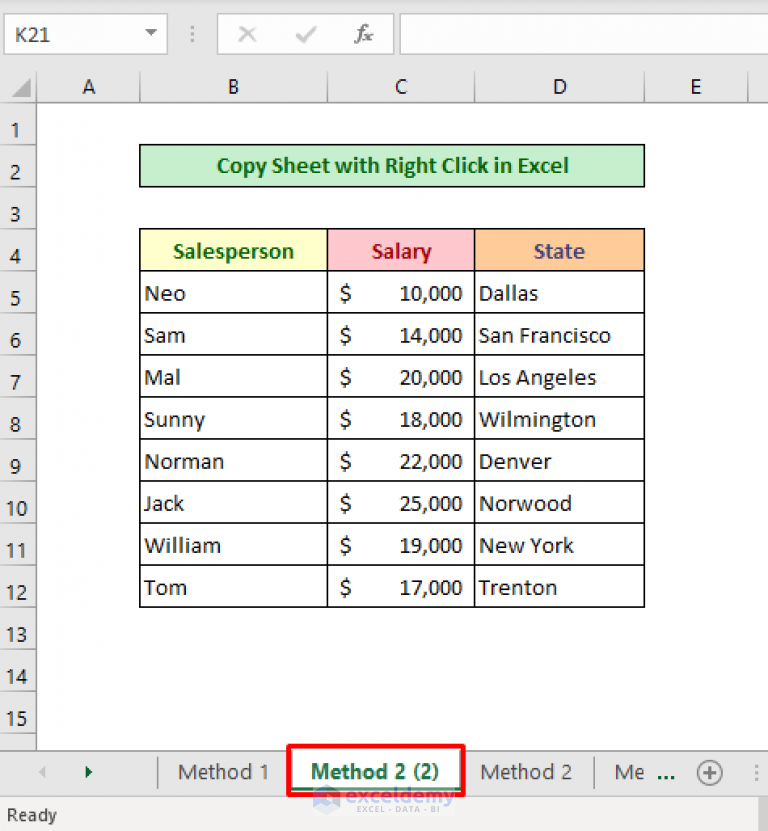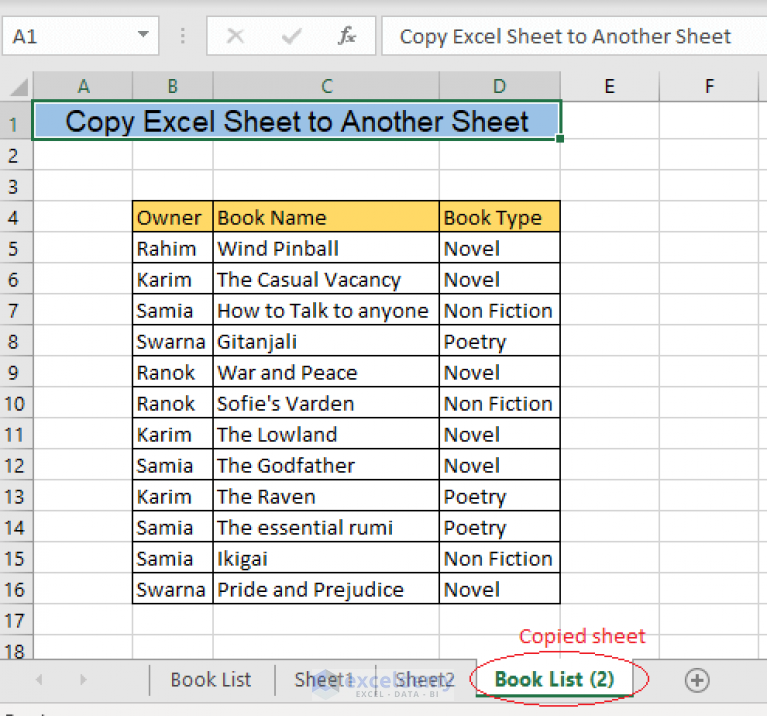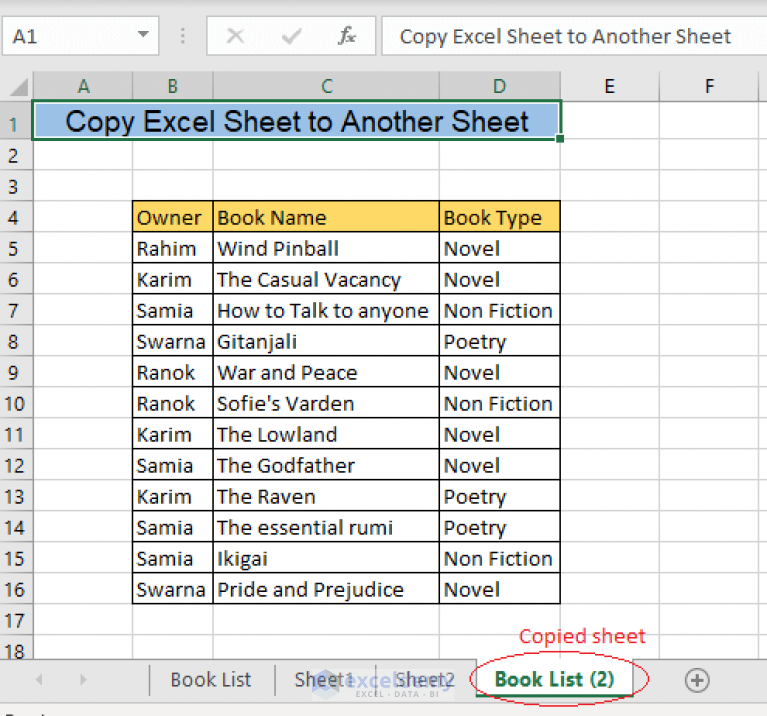Effortlessly Copy Excel Sheet 1 to Sheet 2 Guide

Mastering Excel spreadsheets can significantly boost your productivity, especially when it comes to managing large datasets or performing repetitive tasks. One common task in Excel is copying data from one sheet to another. While this might seem straightforward, many users find themselves struggling with the nuances of this process, especially when dealing with complex formulas or extensive formatting. In this guide, we'll walk you through the steps to effortlessly copy Excel Sheet 1 to Sheet 2, providing you with both manual and automated approaches to enhance your Excel skills.
Why Copy Sheets in Excel?

- Backup Purposes: Keeping a backup of your data before making changes is always a good practice.
- Data Analysis: You might need to compare or analyze different sets of data without affecting the original.
- Consistency in Formatting: When you need the exact same layout and formatting in multiple sheets.
Manual Method to Copy Excel Sheet

The simplest way to copy a sheet is manually:
- Select the Sheet: Click on the sheet tab at the bottom of Excel that you want to copy.
- Right-Click: Right-click on the sheet tab to bring up the context menu.
- Choose ‘Move or Copy’: In the menu, select ‘Move or Copy.’ A new dialog box will appear.
- Select Destination: From the ‘To book’ dropdown, choose the workbook where you want to copy the sheet. If it’s within the same workbook, you can skip this step.
- Create a Copy: Ensure the ‘Create a copy’ checkbox is ticked.
- Click OK: A new copy of the sheet will be created, which you can rename by right-clicking on the tab and choosing ‘Rename.’
📢 Note: If you're copying to a new workbook, this method will open a new instance of Excel. Remember to save the new workbook!
Using Excel Macros to Copy Sheets

For repetitive tasks or when dealing with multiple sheets, using a VBA (Visual Basic for Applications) macro can streamline your work:
Sub CopySheet()
Dim ws As Worksheet
Set ws = ThisWorkbook.Sheets("Sheet1") ' Change 'Sheet1' to your source sheet name
ws.Copy After:=ThisWorkbook.Sheets(ThisWorkbook.Sheets.Count)
ThisWorkbook.Sheets(ThisWorkbook.Sheets.Count).Name = "Sheet2" ' Rename the new sheet
End Sub
To use this macro:
- Open VBA Editor: Press Alt + F11 to open the VBA editor in Excel.
- Insert New Module: Click 'Insert' > 'Module' to add a new module.
- Paste the Code: Copy and paste the above macro into the module.
- Modify Sheet Names: Adjust the sheet names within the code if necessary.
- Run the Macro: Close the VBA editor, go to 'Developer' > 'Macros', select 'CopySheet' and click 'Run'.
This macro will create an exact duplicate of 'Sheet1' after the last sheet in your workbook, renaming it to 'Sheet2.'
Advanced Techniques

Selective Copying

Sometimes, you only need to copy certain ranges or elements:
- Range: Use
Range("A1:B10").Copy Destination:=Sheets("Sheet2").Range("A1"). This will copy cells A1 to B10 from Sheet1 to the same location in Sheet2. - Objects or Formulas: Use the ‘Select’ feature in Excel to choose specific parts of the sheet for copying, then use Ctrl+C and Ctrl+V to paste into Sheet2.
Preserving Formatting

When copying, if you want to keep:
- Formulas: Ensure the paste option is set to ‘Formulas’. If the formula references Sheet1, it will continue to do so in Sheet2.
- Formatting: Choose ‘Paste Special’ > ‘Formats’ to maintain styles without overwriting data in the destination.
| Paste Option | Result |
|---|---|
| All | Copies everything: values, formatting, formulas, and comments. |
| Values | Copies only the values, removing formulas and formatting. |
| Formats | Copies only the cell formatting without altering the values. |
| Formulas | Keeps the formulas intact but doesn't copy the formatting. |

💡 Note: Using 'Paste Special' gives you control over what gets copied, which can be crucial in complex datasets.
Whether you're manually copying sheets or using macros, understanding how to manage and copy data in Excel is essential for efficient spreadsheet use. It's not just about the technical steps but also understanding how to apply these techniques in real-world scenarios, ensuring data integrity, and maintaining consistency across sheets.
To wrap up our guide, let's touch upon the key points covered:
- Manual copying can be done through the 'Move or Copy' option, offering a straightforward approach suitable for occasional needs. - Macros provide automation, reducing the risk of errors in repetitive tasks. - Advanced techniques like selective copying and preserving formatting cater to specific scenarios, enhancing your control over the data transfer.
With this guide, you're now equipped with the knowledge to copy Excel sheets effortlessly, making your spreadsheet management more efficient and effective.
Can I copy multiple sheets at once in Excel?

+
Yes, you can copy multiple sheets by selecting them (holding Ctrl while clicking), then following the manual method described. However, automating this via VBA might require modifying the macro to loop through sheets.
How do I handle errors when copying sheets with VBA?

+
Incorporate error handling in your VBA script using ‘On Error GoTo’ to manage and address potential issues like sheets not existing or being protected.
What happens to cell references when I copy a sheet?

+
Relative cell references in formulas will adjust to the new sheet. If you need absolute references to remain pointing to the original sheet, use sheet-specific references (e.g., Sheet1!A1).